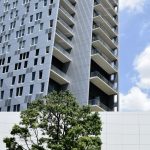Don’t Let the Sun Catch You Cryin’
May 4, 2021
By Raul Larios
A climate crisis is looming to be sure, but don’t let the sun catch you cryin’, as the title of the Ray Charles song says. That’s because New York City can do its part, in a very big way, to help prevent it.
Unlike other cities in the United States where most of their greenhouse gas (GHG) emissions emanate from vehicular traffic (Los Angeles) or heavy industry (Pittsburgh), the number one culprit in New York City is by far its built environment. Over 1 million buildings dot our five boroughs. Many of them are inefficient and highly polluting, causing nearly ±70% of the city’s poisonous emissions. You see, toxic carbon emissions are one of the byproducts of heating, cooling, lighting, and powering buildings.

About 35,000 of the largest structures (those over 25,000 square feet) are responsible for nearly half of that 70% total. And of those, a shocking 15,000+ scored a letter grade of C or worse (the “dirty 15” of New York, as I like to call them). They include the Chrysler building (C), the Dakota (C), the Citigroup headquarters in Midtown (C), the Lipstick building (D), Macy’s Herald Square (D), Trump International Hotel & Tower (D), the Seagram Building (D), the Ansonia (D), the New York Stock Exchange (D) and 30 Hudson Yards (F).
You might be thinking that 15,000 is a tiny number of buildings to clean up relative to a million, right? The low-hanging fruit, so to speak.
Don’t be fooled, as I was, when I first started to look at this issue. It’s actually going to take a heap of work, lots of innovative technologies, and a bundle of money to clean up the dirty 15, not to mention the rest of the built environment. For starters, these buildings are going to need major, very expensive energy efficiency upgrades. Well, who’s going to pay for them and how are those expenditures going to be financed?
These buildings are also going to have to switch from fossil-powered heating and hot water systems to electricity-powered approaches. Do affordable technologies even exist to do that? Will the upgrades pay for themselves from the utility savings?
Last but certainly not least, the source of the electricity to run these new systems will have to be generated by solar, wind and other clean renewable energies. Do the installed capacities even exist? If not, what’s the timeline to get them up and running?
As you can see, cleaning up our built environment is not going to be easy. There’s no low-hanging fruit here.
Ready to Make a Difference?
How we get to a clean built environment from where we are today is what this blog series will be all about. Together, we will do deep dives into the different issues. We’ll look at the regulatory and legal obstacles. We’ll explore the financial challenges to pay for it. We’ll also talk to different entrepreneurs and startups about promising technologies they are developing. Most importantly, we’ll explore ways in which YOU can make a difference.
My name is Raul and I’ve come to realize that a climate crisis is indeed unfolding around the globe. I’m neither in the energy or real estate industries, but I want to do something, anything, about the looming calamity. To that end, I joined the local nonprofit GreenHomeNYC that is dedicated to promoting an energy efficient and sustainable built environment in our beloved city. They do an outstanding job providing sustainability information to the general public through a diverse array of programming, events, peer-to-peer mentoring, and networking opportunities.
I’m writing this blog series on their behalf to explore some of the issues. But it’s also a way of educating myself about the many complex angles to the problem and of turning these awful pandemic times into something personally constructive and positive.
So let’s get started…in Part 2 of the series we’ll look at the political future of Local Law 97 (LL97). The Democratic primaries are just around the corner (scheduled for June 22). Are the City Council members who voted for LL97 term-limited; will they win re-election? Will the potential replacements be supportive of LL97? What about the mayoral candidates?
Interested in learning more about a Green Career? Check out our upcoming June Green Careers event.
